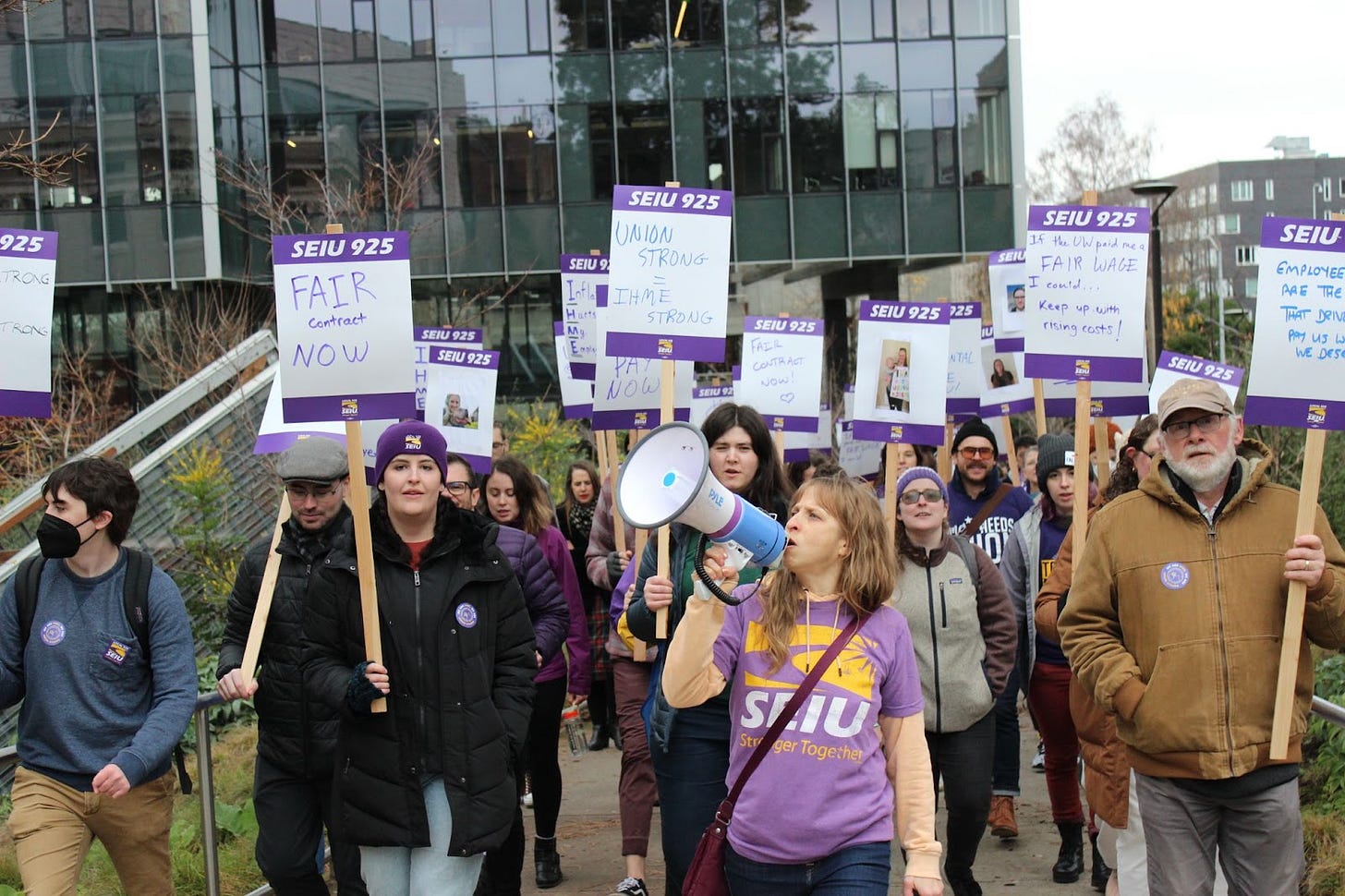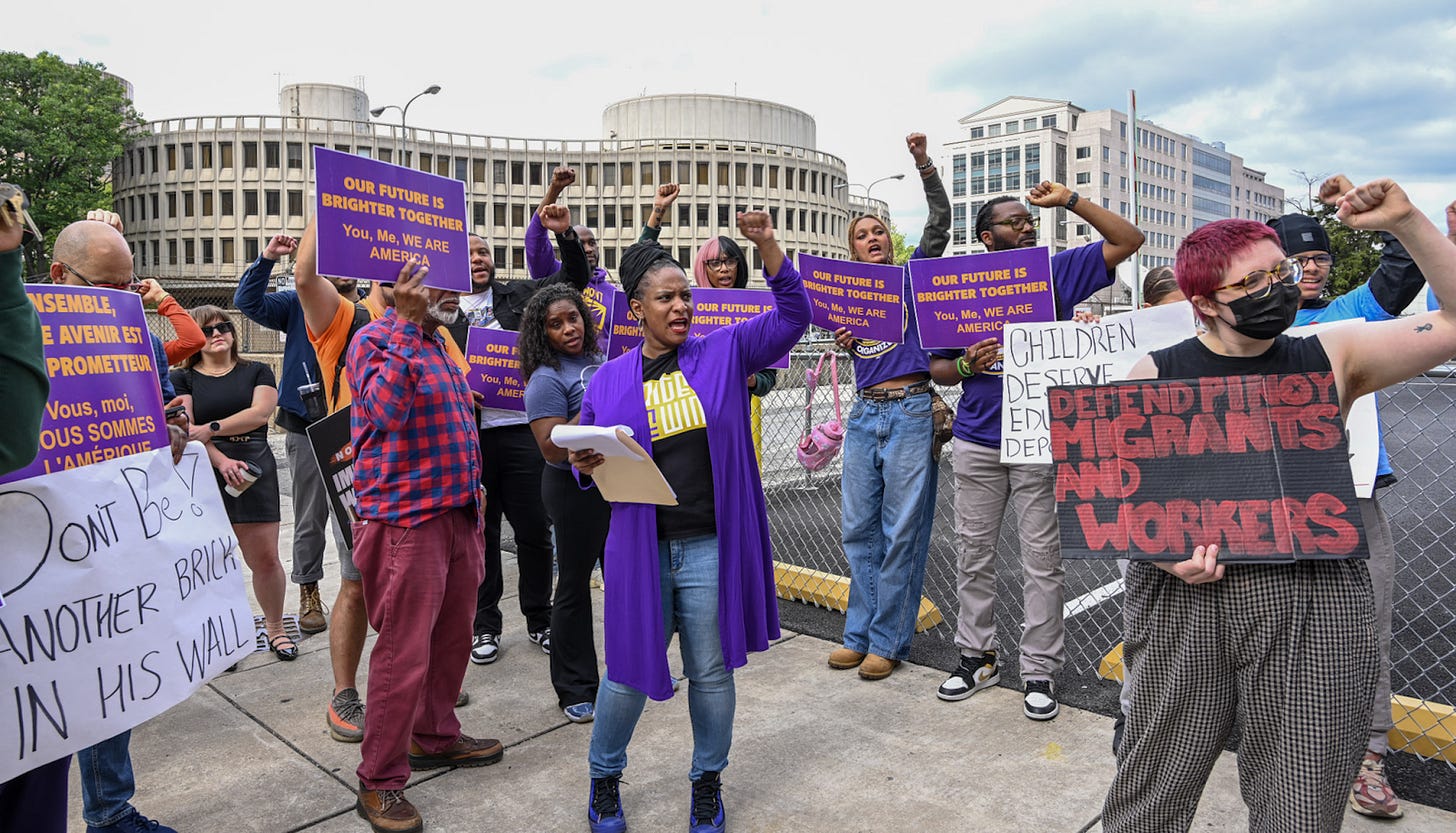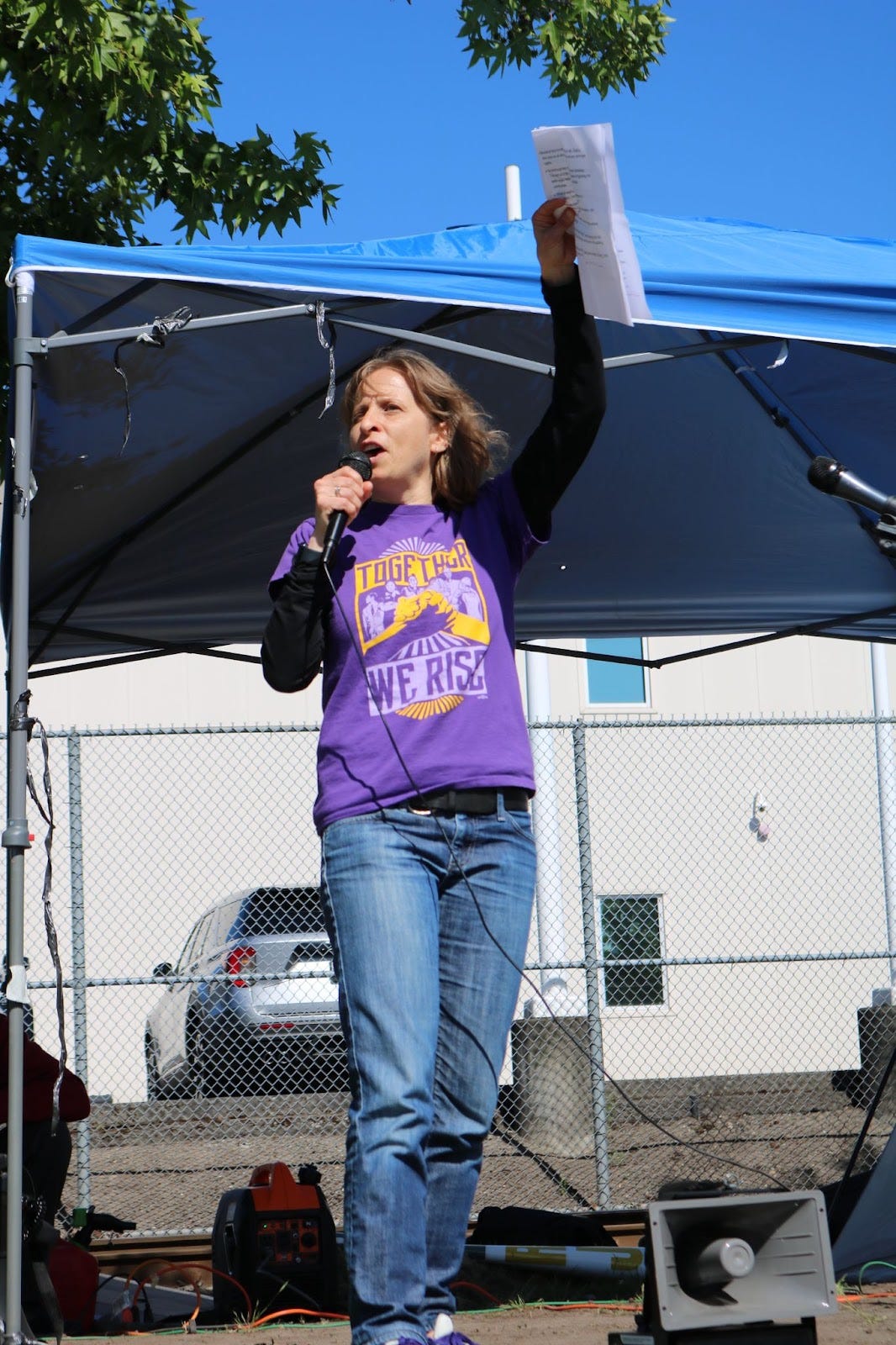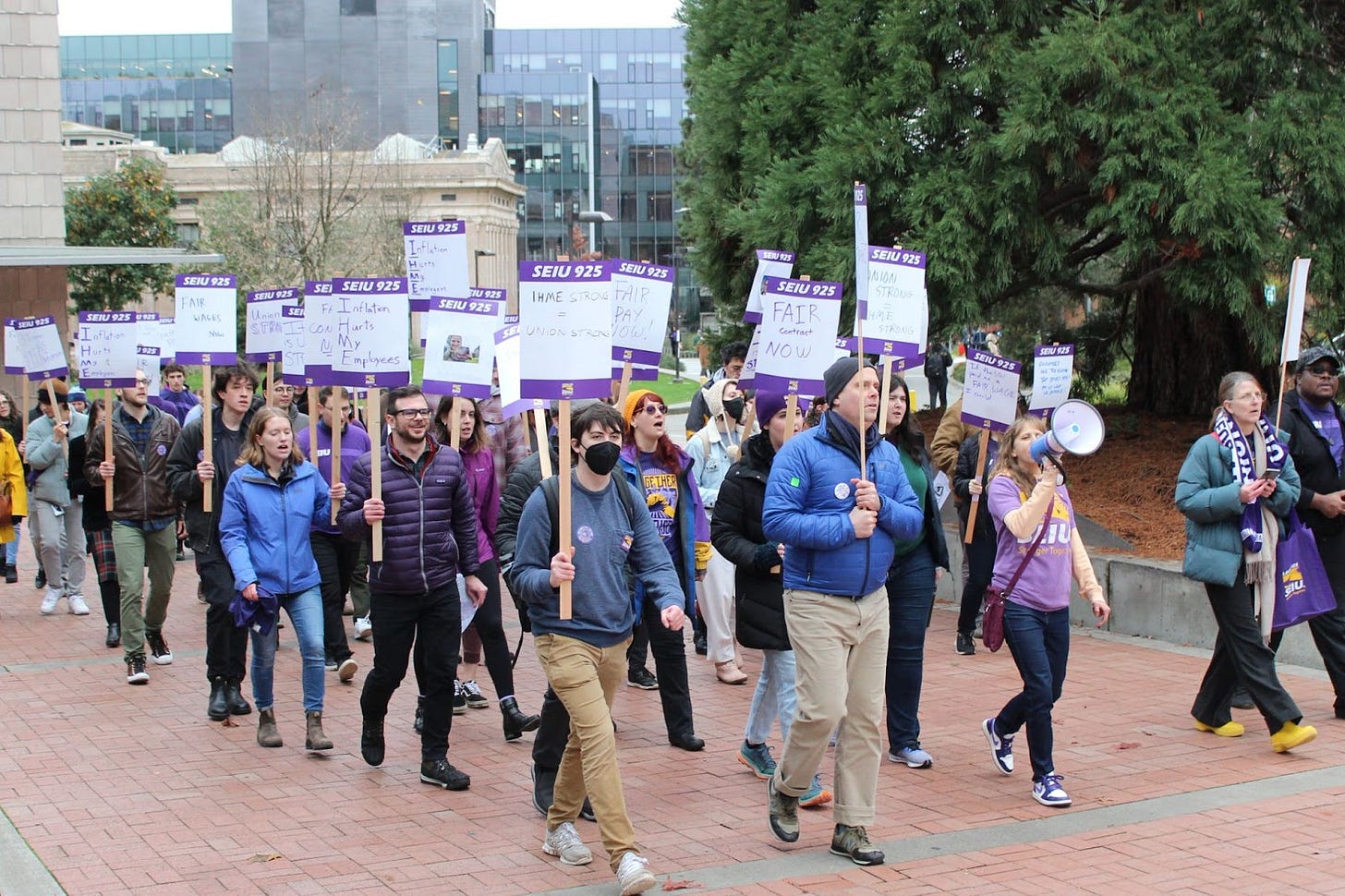SEIU 925 and Lewelyn Dixon’s Fight for Freedom
On the Line interviewed Tricia Schroeder, President of SEIU Local 925, on their campaign to free Lewelyn Dixon, a member of Local 925 at the University of Washington. Lewelyn was held in ICE detention since February before being released after a community and labor campaign for her release in early June. The following interview has been edited for length and clarity.
Jeff Rosenberg (JR): Since the start of Trump’s second term, we’ve witnessed a campaign of fear, raids, and deportations against our immigrant communities. One case in particular was Lewelyn Dixon, known to her community as “Auntie Lynn,” a 925 member detained by ICE soon after Trump inauguration. Can you walk us through what happened and why your union decided it was important to fight for Lewelyn’s freedom?
Tricia Schroeder (TS): We’ve long been involved in defending immigrant workers as a union. After Trump’s election last November, we rolled out “know‑your‑rights” training for our members – teaching workers what to do if ICE shows up at your workplace or attempts to question you. But when Lewelyn was taken after returning from a trip, it hit home: we weren’t prepared for what to do when one of our members was detained.
The family reached out, saying, “Our auntie’s been taken, we need help.” It was clear – this fight wasn’t just about workplace raids anymore – it was about saving someone’s job, their family, their life. We also knew this wouldn’t be the last and we needed to figure this out.
University of Washington, where she works, initially said there was nothing they could do. But once students and faculty began speaking out, we pushed the boss toward holding her job and engaging with the case. Public pressure forced their hand so they didn’t just wash their hands of any responsibility to Lewelyn.
Within 24 hours of Lewelyn’s detention, we launched a petition inside the university, which quickly spread. By day three, it spread across SEIU and immigrant networks, making sure more and more people knew about Lewelyn’s case. That same week, another union member – Alfredo "Lelo" Juarez Zeferino, a Washington farmworker leader with Familias Unidas – was detained, and by Thursday or Friday we had hundreds down at the detention center rallying for their release. Within days, there were thousands of signatures, social media posts, and a full‑blown rally – all demanding their freedom.

Almost immediately, more detainments followed: Rumeysa Ozturk in Massachusetts, taken off the streets just for writing an op-ed, and another sister from California shipped to Tacoma. Each case built toward more urgency. This wasn’t just one fight, it was going to take a movement.
JR: SEIU 925 played a central role in this fight alongside key community organizations and partners. What did it take to build those relationships and this coalition?
TS: That was key. Our members were asking, “What do we do now?” We reached out to La Resistencia – they’ve done actions at the detention center for over a decade now. And then we realized the Filipino community was already organizing for Lewelyn. Instead of trying to figure it out on our own, we joined with them.
We leaned into community leadership. The community did outreach, organized cultural support, while our union pushed the employer, holding them accountable. Together we could do so much more and maintain our resolve and morale throughout this fight.
JR: After ICE detained Lewelyn, they set her hearing date for July. They intended to keep her in detention for at least five long months before any kind of legal process. You all fought to move that hearing date up. What does that say about the way this system works, and how did you ultimately win the fight to move up the hearing?
TS: It was shocking. Waiting until July is just cruelty, plain and simple. By then, we were building real pressure on them with our actions outside the detention center and calling on elected officials to act. To our surprise, we got the hearing moved up sooner. It was a small victory, but still meant months of detainment for Lewelyn. It showed us how unjust and inhumane the system is: tearing people from jobs, families, and communities, and no political will to fix it. It reinforced that our work must continue.
JR: What should people know about the detention centers that they don't see in the media?
TS: Many think ICE detention isn’t cruel because they assume “these are bad people.” But they’re co‑workers, neighbors, moms and dads who have built their lives here for decades. When Lewelyn and others got out, they told us about unsanitary conditions, scarce food, no access to medicine. They slept on floors; laundry smelled foul; bathrooms were filthy. When people lose hope, especially if family or legal help isn’t there, it’s terrifyingly bleak. That’s why our presence outside matters, to remind people they aren’t forgotten.
Companies like GEO Group are profiting off of this suffering too. The detention center in Tacoma is a private for-profit operation. They get paid per detainee per day, regardless of quality of conditions. The more the detainees suffer, the lower the cost and higher their profit. It’s exploitative and cruel, pure extraction on human misery.
JR: In the labor movement, we often talk about the boss’ tactics on the job, especially their efforts to divide and conquer, pitting us against each other. How do you see that reflected in the demonization of immigrant workers?
TS: It’s classic. Bosses pit U.S.‑born workers against immigrants, claiming resources are too scarce, while hoarding all this wealth. They attack Medicaid, housing, health care – claiming right now they are being used and abused by “illegal immigrants.” Meanwhile, they keep cutting taxes for the wealthy, making it impossible to fund those programs. They try to distract and confuse us. It's the same script: blame your neighbor, coworker, anybody but the boss. This division keeps us from fighting for better wages, safety, and healthcare for all workers.
Now, when communities come together at detention centers – immigrant‑rights groups and labor side-by-side – that unity breaks the script. It drives home that our fights are linked, and together we’re stronger. Putting a human face to the fight is also so important for breaking down the lies and the myths people hear. It’s too easy to imagine someone is a monster until it’s someone you know. That’s why we needed to make sure people knew who Lewelyn – our Auntie Lynn – really is.
Trump’s budget bill represents this perfectly. They claim it defends U.S. citizens by cutting immigrant benefits. But it's masking real harm: cuts hurt millions who will lose access to healthcare, food, housing – while boosting ICE’s budget. All to funnel tax cuts to billionaires. That's the playbook: divide us to keep us weaker and distracted, while robbing us blind.
JR: Fast forwarding to Lewelyn’s hearing – how did you feel that day and what did you expect?
TS: We'd already paved the way with other cases, like Cliona Ward. When her release happened, we made sure a few of us showed up. We had about 20 people and held a press conference. It was emotional, but smaller. For Lewelyn we knew we had to show up with bigger numbers.
We prepped for every outcome: release, denial, appeals. While we were very uncertain about what might happen, Lewelyn’s family remained optimistic that she would be released. We ourselves were anxious – “What if it fails?” – but we were ready to return again and again if need be. That readiness helped us pull a huge crowd that day.
When Lewelyn came out, we weren’t just cheering. We saw that power – the joy of seeing our collective struggle deliver her freedom. That’s what keeps us fighting – knowing we can do this, and we’ll do it again and again until they’re all free.
JR: How did SEIU’s history of fighting for immigrant justice lay the groundwork for this fight?
TS: SEIU and 925 have a long history of fighting for immigrant justice, including the airport protests, TPS campaigns, and standing against travel bans during Trump’s first administration. Our membership is diverse: Latinx, African, Southeast Asian, immigrant workers who are union pillars, community leaders.
That doesn’t mean it was always easy. We needed to do work to help some of our members see why this fight should matter to them. In rural Washington, some asked why they should negotiate for protections for immigrant members in their contracts, especially if they didn’t have many immigrant coworkers. We would talk through what these protections meant for those who really needed them, and the importance of establishing these protections as a workplace standard. It normalizes protections for all workers, making it harder for an employer to reject those same protections for contracts that cover large groups of immigrant workers too.
We developed ongoing ties with the Northwest Immigrant Rights Project. We went from occasional collaborations to constant communication, sharing events, legal updates, and planning together. We quickly found we could do much more together.
Partnerships with the community helped bring the immigrant rights struggle into clear view for our members. It also confirms what we long said: community-labor partnerships are powerful and real. Because immigrants are under attack now, we had no choice but to align. Now we built organizing muscle together. Today, we’re ready for future fights. We’ll mobilize faster together.
JR: What advice do you have for other unions wanting to take on this kind of fight?
TS: Build muscle. Show up. Don’t wait. Participate in the full range of labor and community actions happening right now to stand up against the billionaire agenda, even when it’s difficult or uncomfortable. Tune in to immigrant‑rights actions, know‑your‑rights events, etc.. Get comfortable organizing and getting your people to mobilize and engage in person, not just behind a computer screen. That way, when a major fight comes, you're already mobilized. We don’t have to get ready if we stay ready.
Sometimes we may tell ourselves our members won’t care about something if we feel it doesn’t affect them, but we can’t count people out. By the end of this fight, our members and community cared deeply, some putting far more effort into fighting for Lewelyn’s release then they even did for their own raise. That should tell us something about the power of solidarity to move people to action.
JR: In Los Angeles this past week, ICE majorly escalated their operations against immigrant communities. In the course of the community pushing back against ICE, David Huerta, President of SEIU-USWW and SEIU California, was injured, dragged in the street, and arrested. What was going through your mind when you heard about this?
TS: I actually learned right before I spoke at the Tacoma detention center where we had a rally to release Maximo Londonio, an IAM member detained by ICE. The pushback from the community against this militarized ICE presence in LA was incredible and inspiring. We haven’t seen anything like that till now.
After decades as a political activist, seeing the news about David was one of the rare moments where I was reminded that we are putting our bodies on the line with this work. We can’t predict ICE’s next move. Huerta had a head injury; ended up hospitalized, then detained until his hearing on Monday.
ICE picked the wrong guy – they don’t know what a mistake that is – the President of a union of over 750,000 workers across California. That's the power in our movement now. Everytime they take someone, it sends ripples in the community. Now they took David while he was exercising his First Amendment protected rights, and they have pissed off hundreds of thousands if not millions of people. We are all getting ready for the fights ahead.
JR: You mentioned Know-Your-Rights training earlier as an important part of the early preparation for Trump’s mass deportation campaign. This is still incredibly important work, giving people tools to push back and more confidence. However, ICE is more and more flagrantly disregarding these rights. What does that mean for what it will take going forward to fight back against these attacks on our communities?
TS: ICE is becoming more and more of a threat to us and we need to think about how we fight now. We need multi-layered resistance. The people driving and defending these cruel policies right now care about one thing most – their profits. Consumer boycotts and pressure campaigns against Tesla, Target, Starbucks, Amazon have all helped deal economic damage to them. That’s power: disrupting profit. We need more economic disruption, petitions to spread awareness and organize, and rallies and actions to get our people in the streets.
JR: What messages do you want to send – first to the labor movement, then to the bosses and politicians fueling these attacks?
TS: To labor: all working people need and want the same things – dignity, family security, safe jobs, health care. Whether immigrant or U.S.‑born, we’re aligned. We must build solidarity now so we're ready together.
To the billionaires and politicians: we see you. We know your playbook – divide us, cut our benefits, pad your pockets. But your strategy is failing. We won’t back down. You may try to deport us, arrest us, break our spirits, but we won’t back down. We’ll stay until every last person is free.










